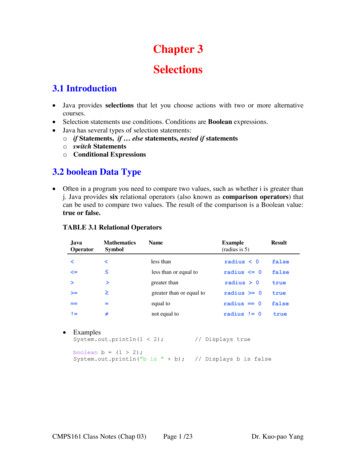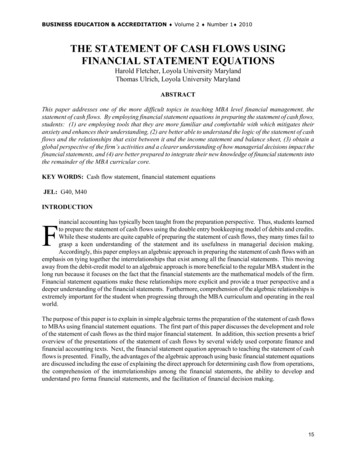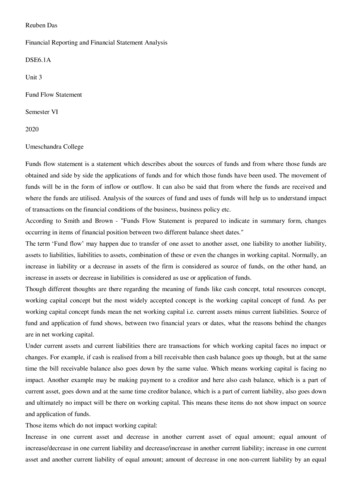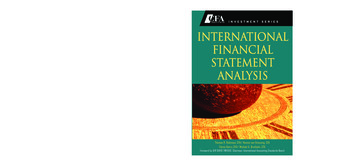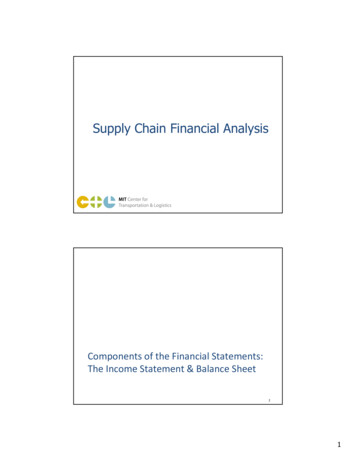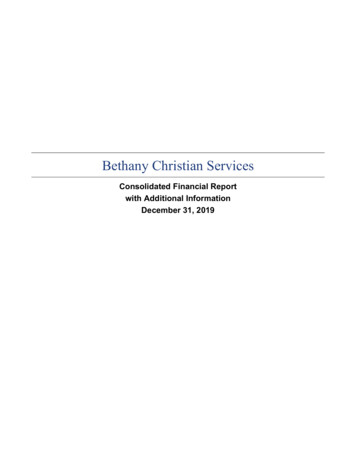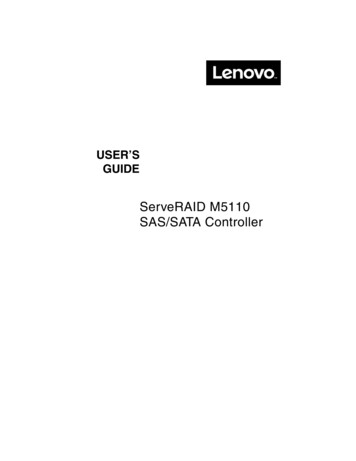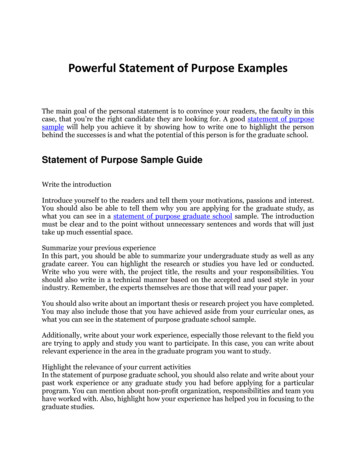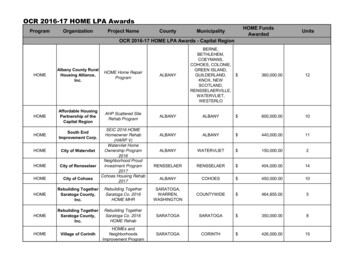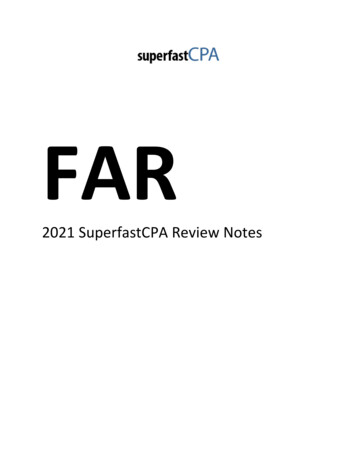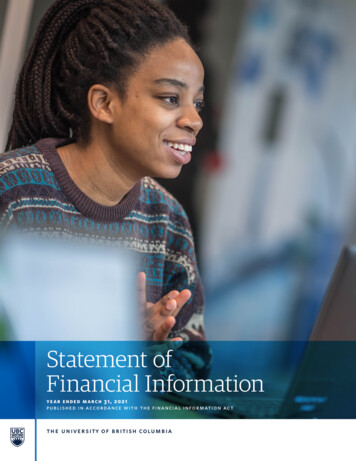
Transcription
Statement ofFinancial Informationy e a r e n d e d m a r c h 3 1 , 2 02 1p u b l i s h e d i n ac c o r da n c e w i t h t h e f i n a n c i a l i n f o r m at i o n ac t
STATEMENT OF FINANCIAL INFORMATIONYEAR ENDED MARCH 31, 2021Published in Accordance with the Financial Information ActTable of ContentsStatement of Management Responsibility .Independent Auditors’ Report .12Consolidated Financial Statements (audited):Consolidated Statement of Financial Position .6Consolidated Statement of Operations and Accumulated Surplus . .7Consolidated Statement of Changes in Net Debt .8Consolidated Statement of Cash Flows . .9Consolidated Statement of Remeasurement Gains and Losses . .10Notes to the Consolidated Financial Statements .11Statement of Financial Information (unaudited):Schedule of Debts . .40Schedule of Indemnity and Guarantee Agreements 40Schedule of Remuneration and Expensesin Respect of the Members of the Board of Governors . .41Schedule of Remuneration and ExpensesPaid to Employees or On Behalf of Employees .42Schedule of Payments for Goods and Services .143Schedule of Grants Paid to Other Agencies . 176
CONSOLIDATED FINANCIAL STATEMENTSYEAR ENDED MARCH 31, 2021Statement of Management ResponsibilityThe consolidated financial statements of the University of British Columbia (the University) have been prepared bymanagement in conformity with Section 23.1 of the Budget Transparency and Accountability Act of the Province ofBritish Columbia supplemented by Regulations 257/2010 and 198/2011 issued by the Province of British ColumbiaTreasury Board outlined in note 2(a). The consolidated financial statements present the financial position of theUniversity as at March 31, 2021, and the results of its operations, remeasurement gains and losses, and the changesin net debt and changes in its cash flow for the year ended March 31, 2021.In fulfilling its responsibilities and recognizing the limits inherent in all systems, management has developed andmaintains a system of internal control designed to provide reasonable assurance that the University assets aresafeguarded from loss and that the accounting records are a reliable basis for the preparation of financial statements.The Board of Governors is responsible for reviewing and approving the consolidated financial statements, andoverseeing management’s performance of its financial reporting responsibilities.The Board of Governors carries out its responsibility for review of the consolidated financial statements principallythrough its Audit Committee. The Audit Committee meets with management, the external auditors and the internalauditors to discuss the results of audit examinations and financial reporting matters. The external and internal auditorshave full access to the Audit Committee, with and without the presence of management.The consolidated financial statements for the year ended March 31, 2021 have been reported on by the Office of theAuditor General of British Columbia. The Independent Auditors’ Report outlines the scope of the audit and providesthe audit opinion on the consolidated financial statements.[signed][signed]Santa OnoPresident and Vice-ChancellorPeter SmailesVice-President Finance & OperationsJune 24, 2021Page 1
INDEPENDENT AUDITOR'S REPORTTo the Board of Governors of the University of British Columbia, andTo the Minister of Advanced Education and Skills Training, Province of British ColumbiaQualified OpinionI have audited the accompanying consolidated financial statements of the University of BritishColumbia (“the group”), which comprise the consolidated statement of financial position as atMarch 31, 2021, and the consolidated statements of operations and accumulated surplus, changesin net debt, cash flows, and remeasurement gains and losses for the year then ended, and asummary of significant accounting policies and other explanatory information.In my opinion, except for the effects of the matter described in the Basis for Qualified Opinionsection of my report, the consolidated financial statements present fairly, in all material respects,the financial position of the group as at March 31, 2021, and the results of its operations andaccumulated surplus, changes in net debt, cash flows, and remeasurement gains and losses forthe year then ended in accordance with Canadian Public Sector Accounting Standards (PSAS).Basis for Qualified OpinionI believe that the audit evidence I have obtained is sufficient and appropriate to provide a basisfor my qualified opinion.As described in Note 2(a) to the consolidated financial statements, the group’s accountingtreatment for contributions received from governments and for externally restricted contributionsreceived from non-government sources is to initially record them as deferred revenue (a liability)and then recognize revenue in the statement of operations either on the same basis as the relatedexpenditures occur or, in the case of funds for the purchase or construction of capital assets, torecognize revenue on the same basis as the related assets are amortized. The group was requiredto adopt this accounting policy as prescribed by Province of British Columbia Treasury BoardRegulation 198/2011.Under Canadian Public Sector Accounting Standards, the group’s method of accounting forcontributions is only appropriate in circumstances where the funding meets the definition of aliability. Otherwise, the appropriate accounting treatment is to record contributions as revenuewhen they are received or receivable. In my opinion, certain contributions of the entity do notmeet the definition of a liability, and as such the group’s method of accounting for thosecontributions represents a departure from Canadian Public Sector Accounting Standards.This departure has existed since the inception of the standard, which applies to periods beginningon or after April 1, 2012. Had the group made an adjustment for this departure in the currentyear, the liability for deferred capital contributions as at March 31, 2021 would have been lowerby 1,594 million, revenue, annual surplus and accumulated surplus would have been higher by 1,594 million and net debt would have been lower by 1,594 million.
UNIVERSITY OF BRITISH COLUMBIAIndependent Auditor’s ReportI conducted my audit in accordance with Canadian generally accepted auditing standards. Myresponsibilities under those standards are further described in the Auditor's Responsibilities forthe Audit of the Financial Statements section of my report. I am independent of the group inaccordance with the ethical requirements that are relevant to my audit of the group’s financialstatements in Canada, and I have fulfilled my other ethical responsibilities in accordance withthese requirements.Responsibilities of Management and Those Charged with Governance for the ConsolidatedFinancial StatementsThose charged with governance are responsible for the oversight of the financial reportingprocess. Management is responsible for the preparation and fair presentation of the consolidatedfinancial statements in accordance with Canadian Public Sector Accounting Standards, and forsuch internal control as management determines is necessary to enable the preparation of theconsolidated financial statements that are free from material misstatement, whether due to fraudor error.In preparing the consolidated financial statements, management is responsible for assessing thegroup’s ability to continue as a going concern, disclosing, as applicable, matters related to goingconcern and using the going concern basis of accounting when the group will continue itsoperations for the foreseeable future.Auditor’s Responsibilities for the Audit of Financial StatementsMy objectives are to obtain reasonable assurance about whether the group’s financial statementsas a whole are free from material misstatement, whether due to fraud or error, and to issue anauditor’s report that includes my opinion. Reasonable assurance is a high level of assurance, butis not a guarantee that an audit conducted in accordance with Canadian generally acceptedauditing standards will always detect a material misstatement when it exists. Misstatements canarise from fraud or error and are considered material if, individually or in aggregate, they couldreasonably be expected to influence the economic decision of users taken on the basis of theseconsolidated financial statements.As part of an audit in accordance with Canadian generally accepted auditing standards, I exerciseprofessional judgment and maintain professional skepticism throughout the audit. I also: Identify and assess the risks of material misstatement of the consolidated financialstatements, whether due to fraud or error; design and perform audit proceduresresponsive to those risks, and obtain audit evidence that is sufficient and appropriate toprovide a basis for my opinion. The risk of not detecting a material misstatementresulting from fraud is higher than one resulting from error, as fraud may involvecollusion, forgery, intentional omissions, misrepresentations, or the override of internalcontrol.
UNIVERSITY OF BRITISH COLUMBIAIndependent Auditor’s Report Obtain an understanding of internal control relevant to the audit in order to design auditprocedures that are appropriate in the circumstances, but not for the purpose ofexpressing an opinion on the effectiveness of the group’s internal control.Evaluate the appropriateness of accounting policies used and the reasonableness ofaccounting estimates and related disclosures made by management.Conclude on the appropriateness of management’s use of the going concern basis ofaccounting and, based on the audit evidence obtained, whether a material uncertaintyexists related to events or conditions that may cast significant doubt on the group’s abilityto continue as a going concern. If I conclude that a material uncertainty exists, I amrequired to draw attention in my auditor’s report to the related disclosures in theconsolidated financial statements or, if such disclosures are inadequate, to modify myopinion. My conclusions are based on the audit evidence obtained up to the date of myauditor’s report. However, future events or conditions may cause the group to cease tocontinue as a going concern.Evaluate the overall presentation, structure and content of the consolidated financialstatements, including the disclosures, and whether the consolidated financial statementsrepresent the underlying transactions and events in a manner that achieves fairpresentation.Obtain sufficient appropriate audit evidence regarding the financial information of theentities or business activities within the group to express an opinion on the consolidatedfinancial statements. I am responsible for the direction, supervision and performance ofthe group audit and I remain solely responsible for my audit opinion.I communicate with those charged with governance regarding, among other matters, the plannedscope and timing of the audit and significant audit findings, including any significantdeficiencies in internal control that I identify during my audit.I also provide those charged with governance with a statement that I have complied with relevantethical requirements regarding independence and communicated with them all relationships andother matters that may reasonably be thought to bear on my independence, and where applicable,related safeguards.[signed]Stuart Newton, CPA, CAAssistant Auditor GeneralVictoria, British Columbia, CanadaJune 25, 2021
CONSOLIDATED STATEMENT OF FINANCIAL POSITIONAS AT MARCH 31(in thousands of dollars)NoteFinancial AssetsCash and cash equivalentsPromissory notes receivableAccounts receivableHousing and other loans receivableInventories for resalePortfolio investmentsEndowment investments (expendable balance)Investments in government business enterprisesSupplemental pension assets77812(a)LiabilitiesAccounts payable and accrued liabilitiesDeferred revenueEmployee future benefitsSupplemental pension liabilitiesDeferred contributionsDeferred capital contributionsDeferred land lease revenueDebt101112(c)12(a)1314151634562021 Net debtNon-Financial AssetsTangible capital assetsEndowment investments (non-expendable balance)Inventories held for usePrepaid expenses177Accumulated surplus Accumulated surplus is comprised of:Accumulated surplusAccumulated remeasurement gains Contractual obligations 032,541,1832020 4,743,2312,222,6892,302,887179,7092,482,596 2,186,13736,5522,222,68921Approved on behalf of the Board of Governors:[signed][signed]Nancy McKenzieChair, Board of GovernorsJessie DusanghChair, Audit Committee(See accompanying notes to the consolidated financial statements)Page 6
CONSOLIDATED STATEMENT OF OPERATIONS AND ACCUMULATED SURPLUSYEAR ENDED MARCH 31(in thousands of dollars)NoteRevenuesGovernment grants and contractsTuition and student feesSales and servicesNon-government grants, contracts and donationsInvestment incomeIncome from government business enterprisesAmortization of deferred capital contributionsGain on sale of government business enterprise2021(Note 27) 20201,247,731 30,993Annual (deficit) surplus(200,536)116,750120,645Accumulated surplus, beginning of earchFacilitiesStudentsCommunity nnual (deficit) surplus from operationsRestricted endowment donationsAccumulated surplus, end of year 1,985,601 2,302,887 2,186,137(See accompanying notes to the consolidated financial statements)Page 7
CONSOLIDATED STATEMENT OF CHANGES IN NET DEBTYEAR ENDED MARCH 31(in thousands of dollars)Budget2021(Note 27)Annual (deficit) surplusExclude items not affecting net debt:Endowment donations and transfers received 116,750 56(111,134)(2,520,542)(2,520,542)(2,409,408) (2,904,078) (2,436,386) (2,520,542)Acquisition of tangible capital assets, net of dispositionsAmortization of tangible capital assetsAcquisition of inventories held for useAcquisition of prepaid expensesConsumption of inventories held for useUse of prepaid expensesNet remeasurement gains (losses)Increase in net debtNet debt, beginning of yearNet debt, end of year(200,536)2020(See accompanying notes to the consolidated financial statements)Page 8
CONSOLIDATED STATEMENT OF CASH FLOWSYEAR ENDED MARCH 31(in thousands of dollars)Cash provided by operating activitiesAnnual surplusItems not affecting cash:Amortization of tangible capital assetsAmortization of deferred capital contributionsAmortization of deferred land lease revenue(Income) loss from government business enterprisesGain on sale of investmentsGain on sale of government business enterpriseOther2021 Change in non-cash operating working capital:Accounts receivablePromissory notes receivableInventories and prepaid expensesAccounts payable and accrued liabilitiesDeferred revenueDeferred contributionsCash used in capital activitiesAcquisition of tangible capital assetsProceeds from disposition of tangible capital assetsDeferred capital contributions receivedCash provided by (used in) investing activitiesPurchase of portfolio investmentsProceeds from sale of portfolio investmentsDistributions received from government business enterprisesInvestment in government business enterprisesReceipt of restricted endowment fundsCash provided by financing activitiesProceeds from issuance of long-term debtPayment of long-term debt and sinking fundPayments received from infrastructure development chargesIssuance of housing loansPayment of housing and other loansIncrease in cash and cash equivalentsCash and cash equivalents, beginning of year116,7502020 7429,98147,525197,121149,596Cash and cash equivalents, end of year 207,102 197,121Supplemental cash flow informationCash paid for interest(See accompanying notes to the consolidated financial statements) 20,546 20,363Page 9
CONSOLIDATED STATEMENT OF REMEASUREMENT GAINS AND LOSSESYEAR ENDED MARCH 31(in thousands of dollars)2021Accumulated remeasurement gains, beginning of year 36,5522020 52,256(Gains) losses reclassified to the Consolidated Statement ofOperations from:Equity investments quoted in active marketOther investments designated at fair value(18,880)(13,724)(3,273)2,660Unrealized gains (losses) from:Equity investments quoted in active marketOther investments designated at fair value152,34623,415(18,499)3,408Net remeasurement gains (losses) for the year143,157(15,704)Accumulated remeasurement gains, end of year 179,709 36,552(See accompanying notes to the consolidated financial statements)Page 10
CONSOLIDATED FINANCIAL STATEMENTSYEAR ENDED MARCH 31, 2021(all tabular amounts are in thousands of dollars)Notes to the Consolidated Financial Statements1Authority and PurposeThe University of British Columbia (UBC or the University) operates under the authority of the University Act ofBritish Columbia. UBC is a comprehensive research university offering a full range of undergraduate, graduateand continuing studies programs. The academic governance of the University is vested in the Senate. As a notfor-profit entity, UBC is governed by a Board of Governors, the majority of whom are appointed by the provincialgovernment of British Columbia. UBC is also a registered charity and is therefore exempt from income taxesunder section 149 of the Income Tax Act.2Significant Accounting PoliciesThe consolidated financial statements of the University are prepared by management in accordance with thebasis of accounting described below. Significant accounting policies of UBC are as follows:(a) Basis of AccountingThe consolidated financial statements have been prepared in accordance with Section 23.1 of the BudgetTransparency and Accountability Act of the Province of British Columbia supplemented by Regulations257/2010 and 198/2011 issued by the Province of British Columbia Treasury Board, referred to as theFinancial Reporting Framework (“FRF”).The Budget Transparency and Accountability Act requires that the consolidated financial statements beprepared in accordance with Canadian Public Sector Accounting Standards (“PSAS”) except as modified byregulation 198/2011. This regulation requires that restricted contributions for acquiring or developing adepreciable tangible capital asset or contributions in the form of a depreciable tangible capital asset are tobe accounted for as deferred capital contributions as described in note 2(d)(ii).Revenue recognized in the Consolidated Statement of Operations and Accumulated Surplus and certainrelated deferred capital contributions are recorded differently under FRF than under PSAS. Note 26summarizes the impact of FRF versus PSAS on the consolidated financial statements.(b) Basis of Consolidation(i) Consolidated EntitiesThe consolidated financial statements reflect the assets, liabilities, revenues, and expenses oforganizations which are controlled by UBC and its proportional interest in government partnerships.Government business enterprises are accounted for by the modified equity method.The following organizations are 100% controlled by the University and are consolidated in these financialstatements. Inter-organizational transactions, balances, and activities have been eliminated onconsolidation. UBC Investment Management Trust Inc. manages the investment assets of the University, includingthe endowment funds, staff pension plan, working capital and other investment portfolios. UBC Foundation, a not-for-profit foundation that develops public awareness and encouragesfinancial support of the University. American Foundation for UBC, an American charitable foundation that encourages financial supportof the University.Page 11
CONSOLIDATED FINANCIAL STATEMENTSYEAR ENDED MARCH 31, 2021(all tabular amounts are in thousands of dollars)2Significant Accounting Policies (continued)(b) Basis of Consolidation (continued)(i) Consolidated Entities (continued) Hong Kong Foundation for UBC, a not-for-profit organization incorporated in Hong Kong thatpromotes and advances all matters concerning education. UK Foundation for the University of British Columbia, an official charitable organization in the UnitedKingdom that promotes and advances all matters concerning education. UBC Asia Pacific Regional Office Limited, a Hong-Kong based association that promotes andadvances the academic and research interests of the University and its partners in the Asia Pacificregion. entrepreneurship@UBC Management Inc. manages UBC’s investments in start-up ventures.(ii) Investment in Government Business EnterprisesGovernment business enterprises are accounted for by the modified equity method. Under this method,the University’s investment in the business enterprise and its net income and other changes in equity arerecorded as earned. No adjustment is made to conform the accounting policies of the governmentbusiness enterprise to those of UBC other than if other comprehensive income exists, which is accountedfor as an adjustment to accumulated surplus (deficit) of the University. Inter-organizational transactionsand balances have not been eliminated, except for any profit or loss on transactions between entities ofassets that remain within the entities controlled by UBC.The following organizations are government business enterprises and are accounted for by the modifiedequity method UBC Properties Investments Ltd. (“UBCPIL”) (100% interest)Great Northern Way Campus Trust (“GNWCT”) (25% interest)Paragon Testing Enterprises Inc. (“Paragon”) (79% interest)(iii) Investment in Government PartnershipsGovernment partnerships are accounted for under the proportionate consolidation method. TheUniversity accounts for its interest in the partnership on a line by line basis in the consolidated financialstatements and eliminates any inter-organizational transactions and balances. Accounting policies of thepartnerships are conformed to those of UBC before it is proportionately consolidated.The consolidated financial statements include the accounts of the following government partnerships: Tri-Universities Meson Facility (“TRIUMF”)The University has a 7.14% interest in TRIUMF which operates a facility supporting fundamental andapplied research in particle and nuclear physics, as well as the materials and life sciences. TRIUMFoperates on the UBC campus and elsewhere. Western Canadian Universities Marine Sciences Society (“WCUMSS”)The University has a 20% interest in WCUMSS, operating as Bamfield Marine Sciences Centre whichprovides a base for marine research in Bamfield, B.C.Page 12
CONSOLIDATED FINANCIAL STATEMENTSYEAR ENDED MARCH 31, 2021(all tabular amounts are in thousands of dollars)2Significant Accounting Policies (continued)(b) Basis of Consolidation (continued)(iii) Investment in Government Partnerships (continued) CDRD Ventures Inc. (“CVI”, formerly DDI Drug Development Inc.)The University has a 33.33% interest in CVI which is the commercialization partner of the Centre forDrug Research and Development (CDRD) and provides financial, managerial and developmentsupport for start-up ventures.(c) Cash and Cash EquivalentsCash and cash equivalents include highly liquid investments with a term to maturity of three months or lessat the date of purchase.(d) Revenue Recognition(i) Unrestricted RevenueGovernment grants that are not restricted to their use and unrestricted contributions and donations arerecognized as revenue when received or receivable. Other unrestricted receipts, including tuition feesand sales of services and products, are reported as revenue at the time the services are provided or theproducts are delivered. Amounts received in advance of services provided or products delivered arerecorded as deferred revenue.(ii) Restricted RevenueExternally restricted grants or donations are recorded as deferred contributions and are recognized asrevenue when the restrictions imposed by the contributors on the use of the monies are satisfied asfollows: Contributions for specific purposes are recorded as deferred contributions and recognized asrevenue in the year in which the stipulation or restriction on the contribution has been met. Restricted capital contributions are initially recorded as deferred contributions and transferred to andrecorded as deferred capital contributions when the amounts have been spent on tangible capitalassets. Restricted contributions spent on acquiring or developing a depreciable tangible capital asset orreceived in the form of a depreciable tangible capital asset, are recorded to deferred capitalcontributions and recognized in revenue at the same rate that the amortization of the tangible capitalasset is recorded. Restricted contributions where the tangible capital asset has an unlimited life, is recorded in revenueand an increase to tangible capital assets. Restricted endowment contributions to be retained in perpetuity are recorded as restrictedendowment donations in the Consolidated Statement of Operations and Accumulated Surplus andare recognized in the period in which they are received or receivable.Page 13
CONSOLIDATED FINANCIAL STATEMENTSYEAR ENDED MARCH 31, 2021(all tabular amounts are in thousands of dollars)2Significant Accounting Policies (continued)(d) Revenue Recognition (continued)(iii) Investment IncomeInvestment income includes interest recorded on an accrual basis, declared dividends and realized gainsor losses on the sale of investments, adjusted for write-downs on investments where the loss in value isdetermined to be other than temporary.The investment income earned on restricted endowments is deferred and recognized when the relatedexpenditure is made or stipulations are met.(iv) Deferred Land Lease RevenueThe University leases certain properties to third parties for a period of 99 years. Land lease revenue isinitially recognized when the contract has been entered into and all performance obligations have beenmet. Subsequently, the land lease revenue is deferred and amortized over the 99 year term of the lease.(e) Financial InstrumentsFinancial instruments are classified into two categories: (i) fair value and (ii) cost.(i) Fair value category: Cash equivalents, portfolio investments that are quoted in an active market,derivatives, private equity investments managed on a fair value basis, and sinking fund investments areall reflected at fair value as at the reporting date. Sales and purchases of investments are recorded onthe trade date. Transaction costs related to the acquisition of investments are recorded as an expense.Unrealized gains and losses on unrestricted financial assets carried at fair value are recognized in theConsolidated Statement of Remeasurement Gains and Losses until such time that the financialinstrument is derecognized due to disposal or impairment. At the time of derecognition, the relatedrealized gains and losses are reclassified to the Consolidated Statement of Operations and AccumulatedSurplus and related balances reversed from the Consolidated Statement of Remeasurement Gains andLosses. Unrealized gains and losses on financial assets related to restricted endowments are includedin deferred contributions on the Consolidated Statement of Financial Position.The carrying value of University’s cash equivalents, accounts receivable and accounts payable andaccrued liabilities approximate fair value due to the short-term maturity of these financial instruments.The financial instruments measured at fair value held within each investment are classified according toa hierarchy which includes three levels, reflecting the reliability of the inputs involved in the fair valuedetermination. The different levels are defined as follows: Level 1: quoted prices (unadjusted) in active markets for identical assets or liabilities Level 2: inputs other than quoted prices included within Level 1 that are observable for the asset orliability, either directly (i.e. as prices) or indirectly (i.e. derived from prices) Level 3: inputs for the asset or liability that are not based on observable market data (unobservableinputs)Page 14
CONSOLIDATED FINANCIAL STATEMENTSYEAR ENDED MARCH 31, 2021(all tabular amounts are in thousands of dollars)2Significant Accounting Policies (continued)(e) Financial Instruments (continued)(ii)Cost / amortized cost catego
The consolidated financial statements of the University of British Columbia (the University) have been prepared by management in conformity with Section 23.1 of the Budget Transparency and Accountability Act of the Province of British Columbia supplemented by Regulations 257/2010 and 198/2011 issued by the Province of British Columbia

